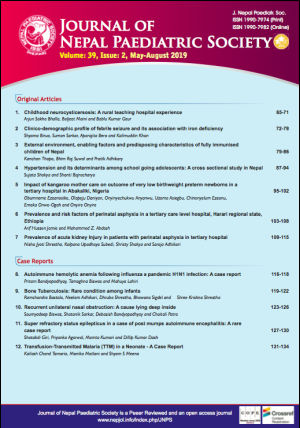Prevalence of Acute Kidney Injury in Patients with Perinatal Asphyxia in Tertiary Hospital
DOI:
https://doi.org/10.3126/jnps.v39i2.27983Keywords:
Acute kidney injury, HIE, Oliguria, perinatal asphyxiaAbstract
Introduction: Perinatal asphyxia has multisystem involvement, kidneys are most frequently affected. This study was conducted to determine the relation between severity of Hypoxic Ischaemic Encephalopathy (HIE) with acute kidney injury in term neonates.
Methods: Retrospective study was done over a period of six months (Sept 2016 to Feb 2017) at Department of Neonatology of a tertiary level maternity hospital. Total 98 cases of Perinatal asphyxia cases which were diagnosed with certain degree of HIE were evaluated for its relation with renal involvement in different stage of HIE.
Results: Out of 98 cases of perinatal asphyxia, HIE I was 21%, HIE II was 69% and HIE III was 10%, among which 72% cases had some degree of renal problem. seventy two cases had renal problem, oliguric cases were 41 (57%) among which 33% case had persistent symptoms and associated renal function deterioration. Among 42 cases of deranged RFTs, 40% of cases has persistently deranged RFTs. In comparison to HIE II in HIE III, 22% of cases had one time derangement of RFTs and 33% cases had at least one observation of oliguria, while remaining 45% cases had persistent deterioration of RFTs and urine output, suggesting that progression in HIE stage has significant association with renal dysfunction (p < 0.05). More than half of the cases of HIE III had mortality while 20.3% of HIE II cases had mortality, indicating that the mortality is highly significant with higher HIE grade (p < 0.05).
Conclusions: Renal involvement is very common in cases of perinatal asphyxia, and severity of renal involvement increases as the HIE grading increases.
Downloads
Downloads
Published
How to Cite
Issue
Section
License
Authors who publish with this journal agree to the following terms:
Authors retain copyright and grant the journal right of first publication with the work simultaneously licensed under a Creative Commons Attribution License that allows others to share the work with an acknowledgement of the work's authorship and initial publication in this journal.
Authors are able to enter into separate, additional contractual arrangements for the non-exclusive distribution of the journal's published version of the work (e.g., post it to an institutional repository or publish it in a book), with an acknowledgement of its initial publication in this journal.
Authors are permitted and encouraged to post their work online (e.g., in institutional repositories or on their website) prior to and during the submission process, as it can lead to productive exchanges, as well as earlier and greater citation of published work (See The Effect of Open Access).



